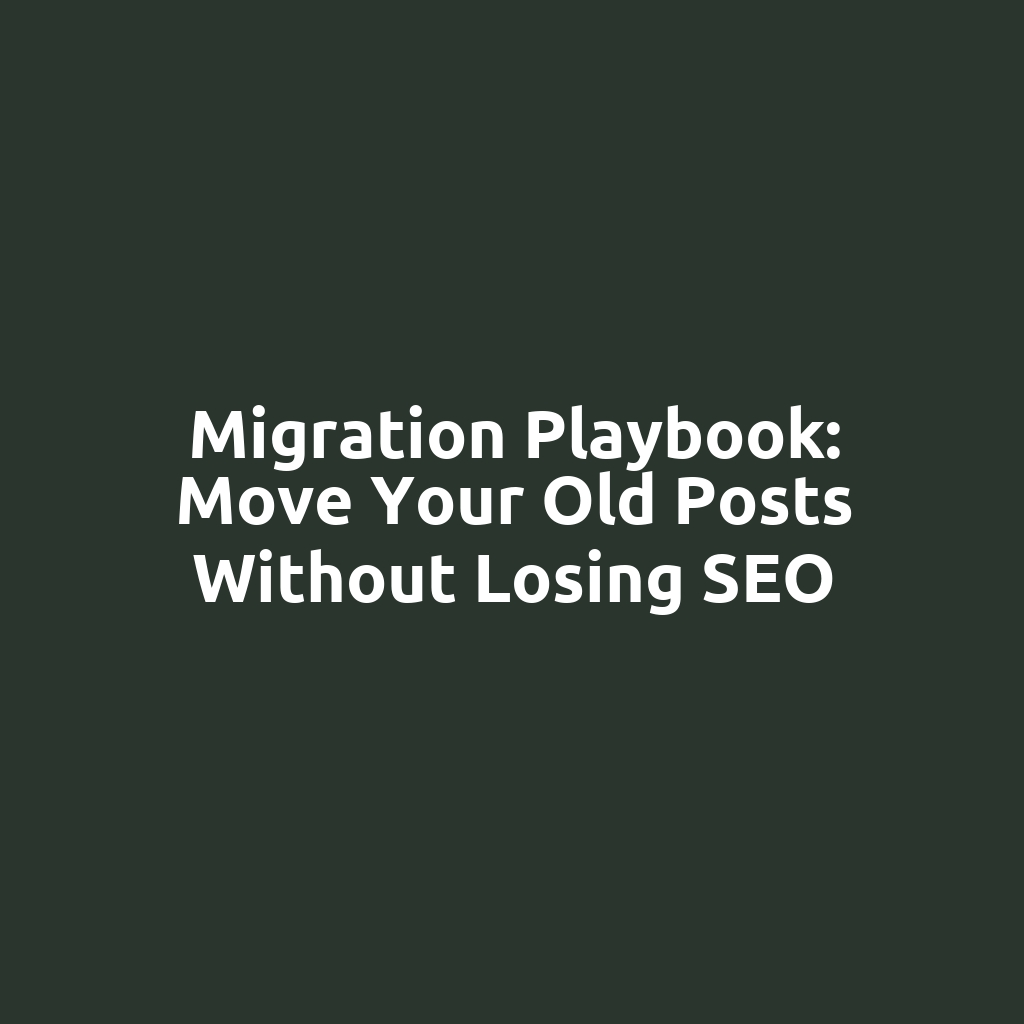Moving old blog posts to a new location can be tricky. This guide, called the Migration Playbook, will help you do it without losing your SEO. SEO stands for Search Engine Optimization. It helps people find your posts online. If you move your posts the wrong way, people might not find them anymore. This guide will show you how to move your posts safely. Let’s learn how to keep your SEO strong while moving your old posts!
Why Moving Posts Can Affect SEO

Moving posts can be like moving houses. Just like changing your address, changing your post’s URL can confuse search engines. If search engines get confused, they might not show your posts to people. This can make your SEO weaker.
There are several reasons why moving posts can affect SEO:
- Broken Links: If you move a post, old links might not work.
- Lost Traffic: If people can’t find your post, fewer people will visit.
- Search Engine Confusion: Search engines might not know where to find your post.
Let’s explore each reason in detail. Understanding these will help us protect our SEO.
Understanding Broken Links

Broken links happen when a URL changes, but the link is not updated. Imagine telling a friend your new house address but forgetting to update your phone number. They might not find you!
When you move a post, you must update all links. If you don’t, people clicking on old links will see an error page. This can frustrate users and hurt your SEO.
Search engines don’t like broken links. They see them as a sign of a messy website. This can lower your site’s ranking. Lower rankings mean fewer people will find your site.
Impact of Lost Traffic

When people can’t find your posts, your site loses traffic. Traffic is the number of people visiting your site. More traffic is good for SEO.
Lost traffic can happen if a post is moved without proper planning. For example, if someone bookmarked your post, they might not find it if the URL changes.
Less traffic can lead to lower ad revenue. If you have ads on your site, fewer visitors mean fewer clicks. This can affect your earnings. That’s why keeping traffic steady is important.
Search Engine Confusion

Search engines use robots to find and index posts. These robots need clear paths to follow. If a post moves, the path changes.
Search engine robots might not know where to find your new post. If they can’t find it, they won’t index it. This means your post won’t show up in search results.
To avoid confusion, you need to guide search engines to your new post. One way to do this is by using a special tool called a redirect.
Using Redirects to Keep SEO Intact

A redirect tells browsers and search engines that a post has moved. It’s like leaving a note with your new address.
There are different types of redirects. The most common one for moving posts is a 301 redirect. This tells search engines that the move is permanent.
Using a 301 redirect helps keep your SEO strong. It passes most of the SEO value from the old URL to the new one. This means your post can keep its ranking.
Steps to Move Posts Without Losing SEO

Let’s go through the steps to move your posts safely:
- Plan Your Move: Decide which posts to move and why.
- Set Up Redirects: Use 301 redirects for all moved posts.
- Update Internal Links: Change links within your site to point to the new URL.
- Check for Broken Links: Use tools to find and fix broken links.
- Monitor Traffic: Watch your site’s traffic to ensure it stays steady.
Following these steps will help you move your posts without losing SEO.
Case Studies: Successful Post Migrations

Let’s look at some examples of successful post migrations:
Example 1: A travel blog moved 50 old posts to a new domain. They used 301 redirects and updated all links. Their traffic stayed the same, and their SEO improved.
Example 2: A tech site reorganized its posts into new categories. They planned the move carefully and checked for broken links. Their site saw a small traffic increase after the move.
These examples show that careful planning and execution can lead to successful post migrations.
Statistics on SEO and Post Migrations

Here are some statistics about SEO and post migrations:
- Over 70% of websites experience traffic loss after a poor migration.
- Sites using 301 redirects retain up to 90% of their SEO value.
- Broken links can decrease site traffic by 15%.
These numbers highlight the importance of careful post migration.
Common Mistakes to Avoid

Here are some common mistakes to avoid when moving posts:
- Not Using Redirects: Always use 301 redirects for moved posts.
- Ignoring Broken Links: Check and fix broken links regularly.
- Rushing the Move: Plan your move carefully to avoid mistakes.
Avoiding these mistakes will help keep your SEO strong.
Conclusion: Key Takeaways

Moving old posts can be tricky, but it’s possible to do it without losing SEO. Remember to use 301 redirects, update links, and monitor traffic. Avoid common mistakes like ignoring broken links. With careful planning and execution, you can move your posts successfully. Keep your SEO strong and ensure your posts continue to reach your audience!
